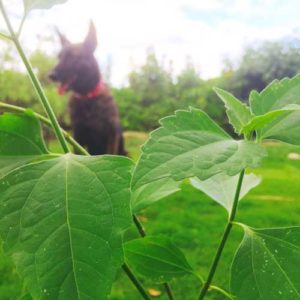DEVIL WEED (Chromolaena odorata)

What and Why: Devil weed is considered one of the world’s worst 100 invasive species according to Oahu Invasive Species Committee (OISC), and is thought to have the potential to be extremely invasive to Hawaiʻi. The plant’s name comes from its leaves, which have three veins that look like a pitch fork. The shrub has pale purple, triangular shaped leaves with toothed edges. When crushed, the plant has a distinct smell of turpentine. The spread of this invasive plant is exacerbated by its tiny fruits, which have soft white hairs that can easily be carried by the wind and water, or eaten and spread by birds. The hairs may also attach themselves like Velcro to passing animals, including human hikers.
A major concern in Hawai‘i is devil weed being toxic to livestock such as cows and horses. In addition, like many invasive plants, devil weed can impede the growth of native species by shading them out and releasing toxins into surrounding soil. It consumes large amounts of water, and therefore negatively affects soil nutrient levels.
Where: First detected in Kahuku Training Area in 2011, devil weed has since been found in other locations around Oʻahu, including Kahana Valley, Pūpūkea and ʻAiea. OISC’s management goal for devil weed is island-wide detection and eradication. More recently, devil weed has been detected on the Big Island, and the Big Island Invasive Species Committee is working to identify the spread and eradicate it.
Who: This project started out with volunteer teams of pet dogs and owners, and now consists of professional teams. We have been impressed with the dogsʻ ability to lead their handlers to plants that are visually obscured by thick vegetation or distance (up to 90 meters away). We report all of our findings to O‘ahu Invasive Species Committee, and we receive their guidance on which priority trails and areas to survey. Our program is mainly based on O‘ahu but we’ve also conducted surveys for Big Island Invasive Species Committee.
Mahalo to Dogtra for providing us with a Pathfinder TRX GPS collar to support our field surveys!

